
|
|

This is a strenuous 30 day trek. Return trip to/from Vancouver including time in Kathmandu is 40 days. Our Climbing Expeditions also use this route to access their mountains.
I love the ten hour bus ride to Jiri (some people don't). You can (should) ride on the roof of the bus, on your luggage, with a picnic lunch and 360 degree views; and then the walking begins. The scale of the land amazes you on the bus ride, but it isn't until you walk up that first hill out of Jiri and look over the sea of terraces, villages, trails and mountain ridges that you see the step by step challenge you've taken on. In the far east is Lamjura La, a pass you'll cross maybe three days from now. And there are still no snow peaks in sight. But your days are full of watching the farming and village life and full of the meeting of passersby. As the caravans of porters stream by with their impossible loads, "Namaste, namaste, namaste", is the constant greeting.
It is most pleasant to fall into this rhythm of days. To watch the porters huddled about their fires in the forest, cooking tsampa and tea. To see the farmers cajoling their buffalos to drag ancient wooden ploughs through the soil. To watch the yellow fields of mustard sway in the breeze, to laugh with two young girls giggling and speechless with crimson red rhododendron blossoms in their jet black hair.
Rounding the ridge beyond Junbesi, we have our first view of the high peaks, and later in the day finally look far down to the Dudh Khosi, the Milk River. This is the river that drains Everest, Lhotse and Cho Oyu, three of the highest mountains in the world. It also marks the turning of our journey northward. Following the Dudh Khosi, we begin our climb up to the Khumbu. At this point, the Mera Climbing Expedition continues eastward to the Hinku Valley.
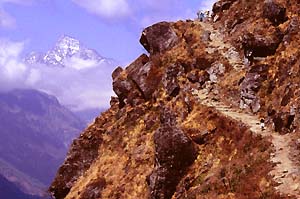
|
|
Langtang |
Everest |
Annapurna |
Climbing Expeditions |
Recommended Reading
Equipment List, Fine Print and Basic Nepalese
Email Tom Carter carter@islandnet.com
Tel: Canada 250-954-2345
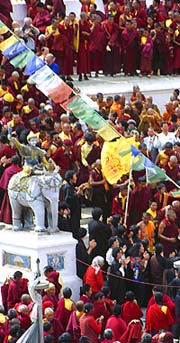 The Khumbu is in the north eastern part of Nepal bordering Tibet, three hundred and twenty kilometers from Kathmandu. All journeys in Nepal begin in Kathmandu. It is a crazy, wild, dirty, amazing, beautiful city full of temples and twisting alleyway bazaars. Kathmandu is right in your face, close! Horns, dogs, vendors, snake charmers, music and the full spectrum of smells! We get permits and papers here, but mostly we enjoy. It is safe to wander the medieval streets, even at night. The greatest hazard is rampant bacteria though it is possible to stay healthy in Kathmandu without paranoia. If you like shopping, you are in big trouble. If you like bartering, you are in heaven. The pre-dawn walk up to Swayambunath temple to hear the monks chanting as the sun rises through the fog is pure magic.
The Khumbu is in the north eastern part of Nepal bordering Tibet, three hundred and twenty kilometers from Kathmandu. All journeys in Nepal begin in Kathmandu. It is a crazy, wild, dirty, amazing, beautiful city full of temples and twisting alleyway bazaars. Kathmandu is right in your face, close! Horns, dogs, vendors, snake charmers, music and the full spectrum of smells! We get permits and papers here, but mostly we enjoy. It is safe to wander the medieval streets, even at night. The greatest hazard is rampant bacteria though it is possible to stay healthy in Kathmandu without paranoia. If you like shopping, you are in big trouble. If you like bartering, you are in heaven. The pre-dawn walk up to Swayambunath temple to hear the monks chanting as the sun rises through the fog is pure magic.
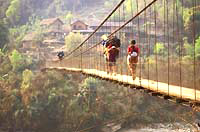 As most people fly to Lukla, this early part of the trek has few westerners on it. We generally get to spend the evening with our host family and it will probably be in their kitchen. It is an intimate time with the local people.
As most people fly to Lukla, this early part of the trek has few westerners on it. We generally get to spend the evening with our host family and it will probably be in their kitchen. It is an intimate time with the local people.
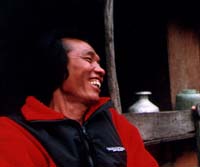 As we walk deeper into Solu Khumbu, the land of the Sherpa people, the evidence of Buddhism grows. Carved stone prayer walls, prayer flags, temples and early morning horns, bells and chants fill the land with a palpable peace. And each day we are that much further from internal combustion engines!
As we walk deeper into Solu Khumbu, the land of the Sherpa people, the evidence of Buddhism grows. Carved stone prayer walls, prayer flags, temples and early morning horns, bells and chants fill the land with a palpable peace. And each day we are that much further from internal combustion engines!
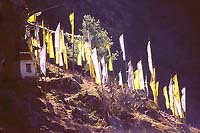 In Junbesi we have a rest day and a chance to walk up a side valley to visit the Thubten Choling monastery. It was built by Tibetan monks fleeing persecution and the destruction of their monastery Rongbuk on the north side of Mount Everest, known to them as Chomolungma: "the Goddess Mother of the Snows". "Om Mani Padme Hung", the mantra of the mountains, is on the monks' lips as prayer wheels spin clinking their bells each turn. "May All Beings Be Happy".
In Junbesi we have a rest day and a chance to walk up a side valley to visit the Thubten Choling monastery. It was built by Tibetan monks fleeing persecution and the destruction of their monastery Rongbuk on the north side of Mount Everest, known to them as Chomolungma: "the Goddess Mother of the Snows". "Om Mani Padme Hung", the mantra of the mountains, is on the monks' lips as prayer wheels spin clinking their bells each turn. "May All Beings Be Happy".